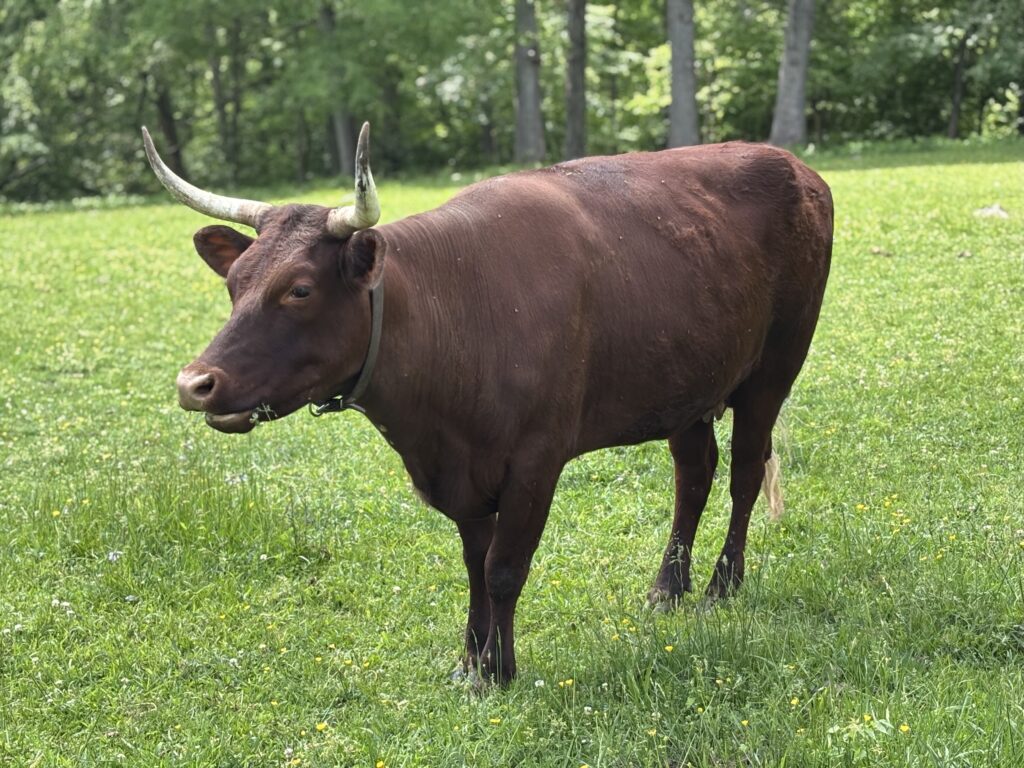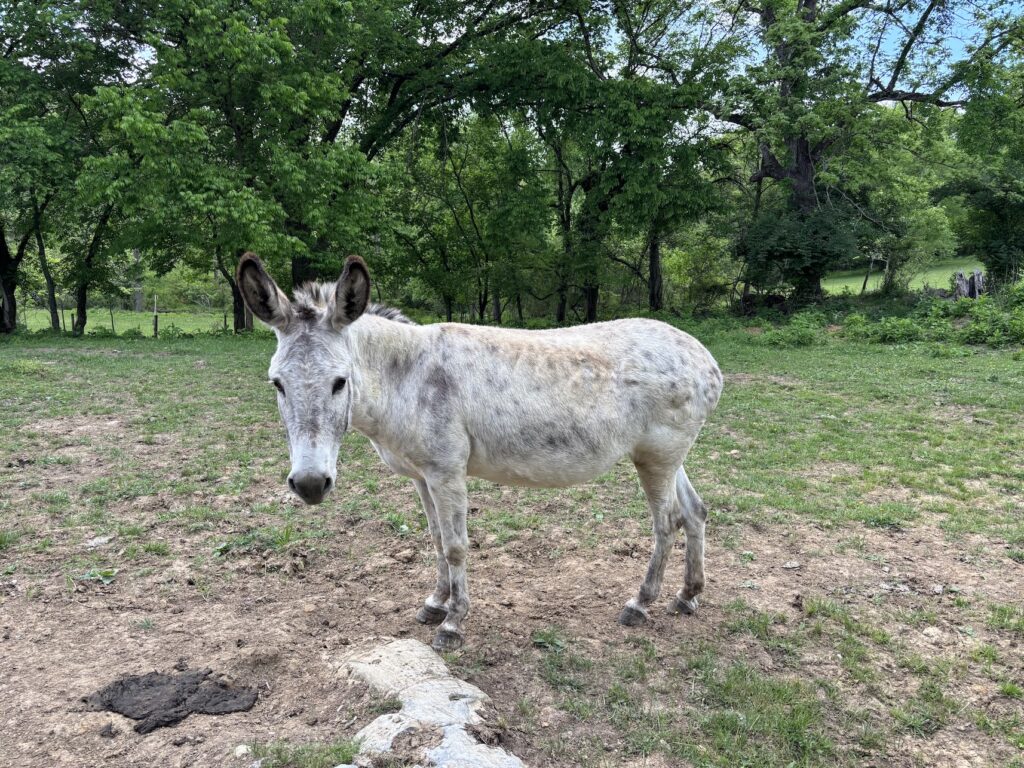Exchange Place is committed to preserving endangered heritage breeds that were common in the 19th century. These unique animals play a vital role in our mission to accurately interpret Northeast Tennessee’s agricultural past.
AMERICAN GUINEA HOGS
The American Guinea Hog (not to be confused with the guinea pig) was one of the most common types of hogs found on homesteads in the antebellum South. Often called “yard pigs,” these hogs would roam around farms like wild children, eating snakes, grass, acorns, and whatever else they could root up. Guinea Hogs are solid black and small in size, rarely reaching over 250 pounds (though they are not a miniature or “pot-bellied” breed). Extremely efficient foragers, Guinea Hogs require little supplemental feed when they are on pasture. They are active but mild mannered and well-suited to a hot climate. They produce an enormous amount of fat—a valuable commodity in early America that was used for a variety of purposes from cooking to soap making to cosmetics.
Along with corn, hogs were the major agricultural commodity in Tennessee in the mid-19th century. (The duo inspired the nickname “The Hog and Hominy State” during that time). East Tennessee in particular produced a large number of hogs, which were often driven overland into the Carolinas or Georgia for sale. Pork was undoubtedly the preferred meat of antebellum Southerners, and it was also one of the most important staples of the slave diet—providing high energy and protein for intense field labor. James Preston, who owned Exchange Place during this time, recorded in his ledger book that he salted over 4,000 pounds of pork in December 1850!
COTSWOLD SHEEP
The Cotswold is a longwool sheep breed developed in England and was first brought to America in the early 19th century. The breed’s name reflects the traditional habitat of the sheep: “cots” for the cotes or small sheepfolds where they were sheltered at night on the “wold” or treeless, hilly land.
According to the 1850 agricultural census, James Preston owned 50 sheep—though what breed, we do not know. In 1860, he owned none. He possibly sold his flock because wool was no longer profitable, especially with the rise of cotton production in the deep South. We have chosen to raise Cotswolds at Exchange Place because of their gentle disposition and lustrous long wool locks, which is a favorite with the Overmountain Weavers Guild members. We have a flock of mixed colors: white, gray, and black.
DOMINIQUE CHICKENS
Chickens were an important part of the antebellum homestead. Often, they would range freely in the yards and pastures and forage for insects, seeds, and plants. (Yes, chickens are omnivores!). In turn, they would provide meat and eggs for the table. At Exchange Place, we keep heritage breeds that are known to have been available in the mid-19th century. To protect them from predators, we confine them to a coop and run covered with netting instead of letting them free-range.
Dominiques, or “Dominikers” as they are commonly called in Appalachia, are a truly American breed, dating back to the early 19th century. Though the origin of the name “Dominique” is unclear, it may come from a French colony in Haiti where some of the birds’ ancestors may have originated. Dominiques have “barred,” or black and white, plumage and are good foragers. The roosters are often spunky and protective of their flock, while the hens are docile and attentive mothers. They are a parent of the Barred Rock breed that gained popularity in the late 19th century.
Though we don’t know for sure if there were Dominiques at Exchange Place in the mid-19th century, we can make an educated guess that these beautiful and now rare birds were pecking around the farmyard while the stagecoaches were traveling through.

AMERICAN MILKING DEVON CATTLE
The American Milking Devon descends from the Devon breed, which was developed over centuries in the southeastern peninsula of England. It is perhaps best known as giving rich milk used for Devonshire cream, but it was also used for draft power and meat, making it a valuable multi-purpose breed.
Devons have a red coat and black-tipped horns. They are bright, compact, and hardy and can thrive on poor pastures and in harsh conditions. These qualities, plus the ease at which this breed could be transported to English ports, made Devons attractive to American colonists. A pair of Devons arrived at Plymouth Colony in 1623, and the breed quickly became a keystone of New England agrciculture. As settlers spread into the growing United States, so did the Devon breed. Many pulled the conestogas that carried pioneers westward on the Oregon Trail. Over time, the pure English stock was “improved” in the United States to become the American Milking Devon.
Nineteenth century agricultural censes indicate that James Preston owned 8 “milch” cows in 1850 and 12 in 1860 and that butter was an important commodity on his farm. In 1850, he produced 500 pounds!
Exchange Place is lucky to have an ambassador of this breed. Look for our beautiful red Devon cow, Bliss, grazing in the pastures alongside our other livestock. She has impressive horns but is well-mannered and docile.
.
MUSTANG HORSES
Exchange Place’s newest equine residents are a pair of mustangs: Thunder, a sorrel gelding, and Lightning, a white and sorrel filly.
Mustangs are free-roaming, feral horses that are descended from the domesticated horses brought to the Americas by the Spanish. The original Spanish equines became foundation stock for many American breeds, including quarter horses.
While we have no documentation as to the presence of mustangs in Eden’s Ridge, TN in the antebellum period, it is certainly within the realm of possibility. Records as early as the 1830s noted wild mustangs being rounded up in Texas and shipped both north and east. Modes of transportation such as the stagecoach utilized wild horse herds as an inexpensive and plentiful source of animals, working in teams of up to eight at a time. The mustang also became the symbol for the Pony Express mail service, with couriers on horseback crossing the nation from Missouri to California from 1860 through 1861. In that Eden’s Ridge was located along a trade route, it is certainly feasible that some mustangs may have made their way to this area in the mid-nineteenth century.

JERUSALEM DONKEY
Donkeys have been in America for centuries and were commonly bred with horses to create mules, an important draft animal. Our donkey, Jenny, is classified as a “Jerusalem” donkey because she has the shape of a cross on her back. An old legend claims that the cross appeared on these donkeys after Christ rode one to his crucifixion.
BARN CATS
Cats were kept on farms to catch the ubiquitous mice that feasted on grain, silage, and other foodstuffs. Cats could be shy and elusive but would often show up at milking time for a taste of fresh milk. Exchange Place currently has several cats that make their home in the large log cow barn.
The mission of Exchange Place Living History Farm is to preserve and interpret the heritage of mid-19th century farm life in Northeast Tennessee. A private, non-profit organization, Exchange Place is maintained and operated primarily by volunteers and is supported by donations, fundraisers, memberships, and grants.

Exchange Place
4812 Orebank Rd,
Kingsport, TN 37664
423-288-6071